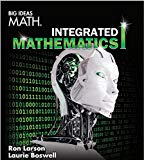
Concept explainers
a.
To find:Type of function for the number of donations collected by organization
a.
Answer to Problem 23E
Number of donation collected as function by organization
Explanation of Solution
Given:
All three organization are collecting donations for a cause.
Concept Used:
Use patterns between consecutive data pairs to determine type of function. Linear function: - The difference of consecutive y-values is constant. Exponential function: - Consecutive y-values have a common ratio. In each case, the differences of consecutive x-values need to be constant.
Calculation:
Linear function: - The difference of consecutive y-values is constant. Exponential function: - Consecutive y-values have a common ratio. In each case, the differences of consecutive x-values need to be constant.
Table &Graph given
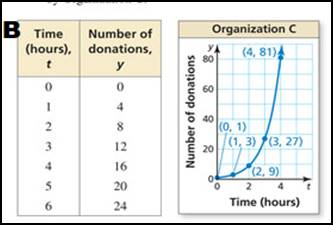
Organization
We determine function of organization
According to the graph of organization
We determine the exponential function for organization
Hence,
Number of donation collected as function by organization
b.
To find:Average rate of change of each function for each
b.
Answer to Problem 23E
Average rates of change for each function calculated.
Explanation of Solution
Given:
All three organization are collecting donations for a cause.
Concept Used:
Use patterns between consecutive data pairs to determine type of function. Linear function: - The difference of consecutive y-values is constant. Exponential function: - Consecutive y-values have a common ratio. In each case, the differences of consecutive x-values need to be constant.
Calculation:
Linear function: - The difference of consecutive y-values is constant. Exponential function: - Consecutive y-values have a common ratio. In each case, the differences of consecutive x-values need to be constant.
Table & Graph given
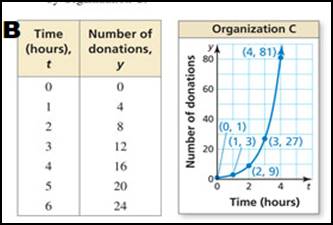
Organization
We determine the average rates of change for each function: -
We determine function of organization
According to the graph of organization
We determine the exponential function for organization
Hence,
Average rates of change for each function calculated.
v.
To find:Which function does average rate of change increase most quickly.
v.
Answer to Problem 23E
The average rate of change increases more quickly for the function
Explanation of Solution
Given:
All three organization are collecting donations for a cause.
Concept Used:
Use patterns between consecutive data pairs to determine type of function. Linear function: - The difference of consecutive y-values is constant. Exponential function: - Consecutive y-values have a common ratio. In each case, the differences of consecutive x-values need to be constant.
Calculation:
Linear function: - The difference of consecutive y-values is constant. Exponential function: - Consecutive y-values have a common ratio. In each case, the differences of consecutive x-values need to be constant.
Table & Graph given

Organization
We determine the average rates of change for each function: -
We determine function of organization
According to the graph of organization
We determine the exponential function for organization
Hence,
The average rate of change increases more quickly for the function
Chapter 6 Solutions
BIG IDEAS MATH Integrated Math 1: Student Edition 2016
 Discrete Mathematics and Its Applications ( 8th I...MathISBN:9781259676512Author:Kenneth H RosenPublisher:McGraw-Hill Education
Discrete Mathematics and Its Applications ( 8th I...MathISBN:9781259676512Author:Kenneth H RosenPublisher:McGraw-Hill Education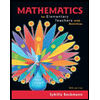 Mathematics for Elementary Teachers with Activiti...MathISBN:9780134392790Author:Beckmann, SybillaPublisher:PEARSON
Mathematics for Elementary Teachers with Activiti...MathISBN:9780134392790Author:Beckmann, SybillaPublisher:PEARSON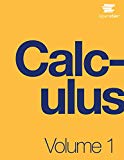
 Thinking Mathematically (7th Edition)MathISBN:9780134683713Author:Robert F. BlitzerPublisher:PEARSON
Thinking Mathematically (7th Edition)MathISBN:9780134683713Author:Robert F. BlitzerPublisher:PEARSON Discrete Mathematics With ApplicationsMathISBN:9781337694193Author:EPP, Susanna S.Publisher:Cengage Learning,
Discrete Mathematics With ApplicationsMathISBN:9781337694193Author:EPP, Susanna S.Publisher:Cengage Learning,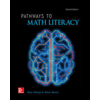 Pathways To Math Literacy (looseleaf)MathISBN:9781259985607Author:David Sobecki Professor, Brian A. MercerPublisher:McGraw-Hill Education
Pathways To Math Literacy (looseleaf)MathISBN:9781259985607Author:David Sobecki Professor, Brian A. MercerPublisher:McGraw-Hill Education





